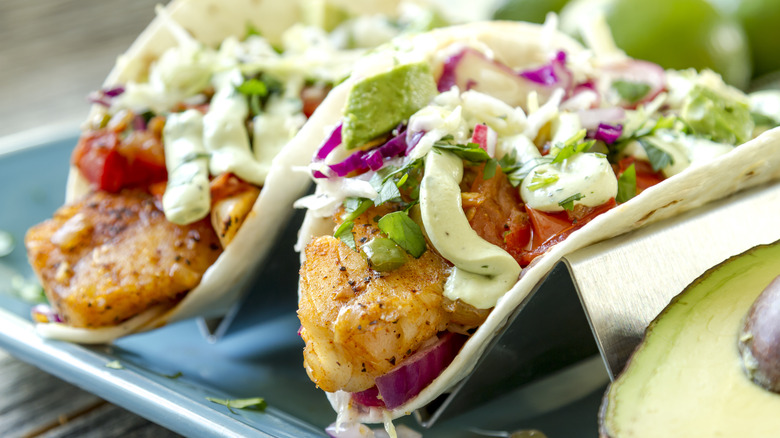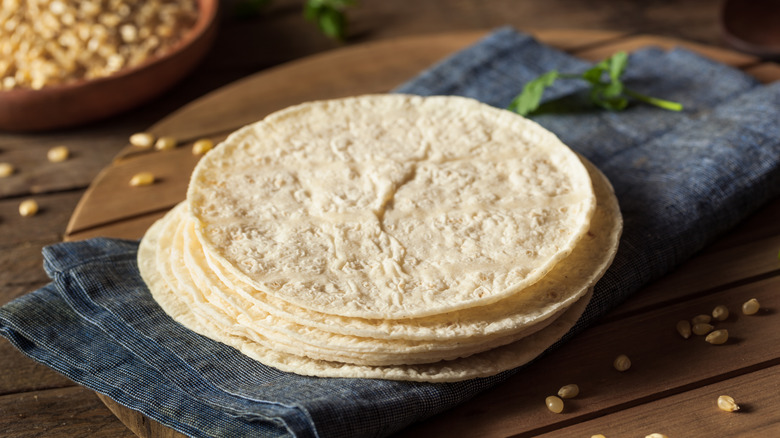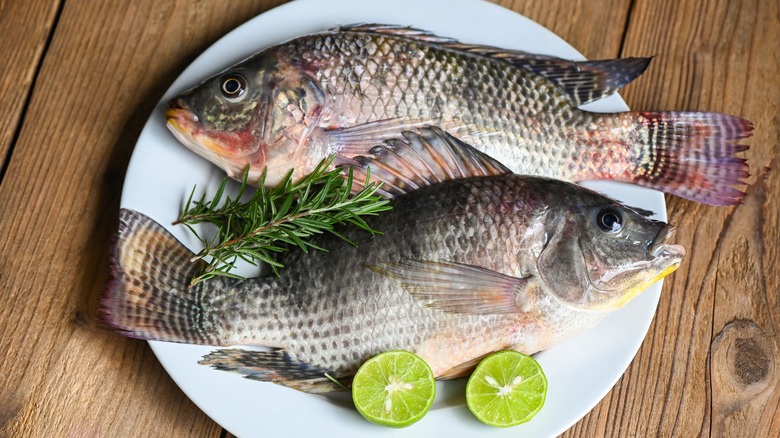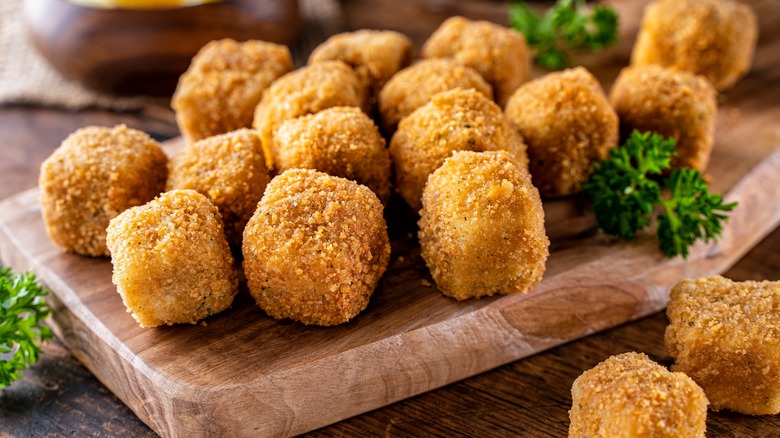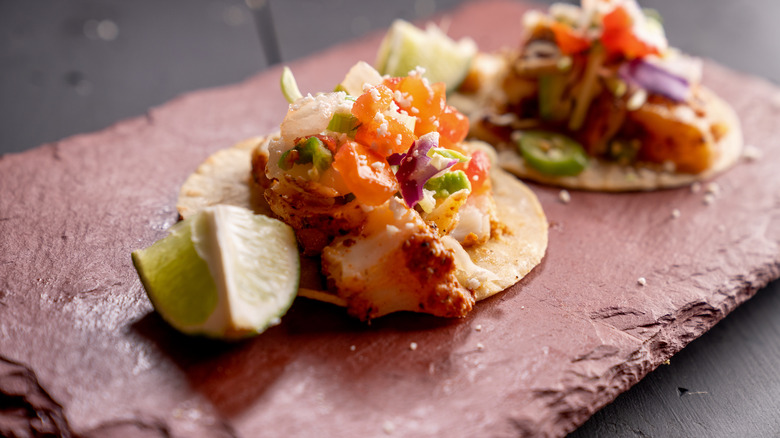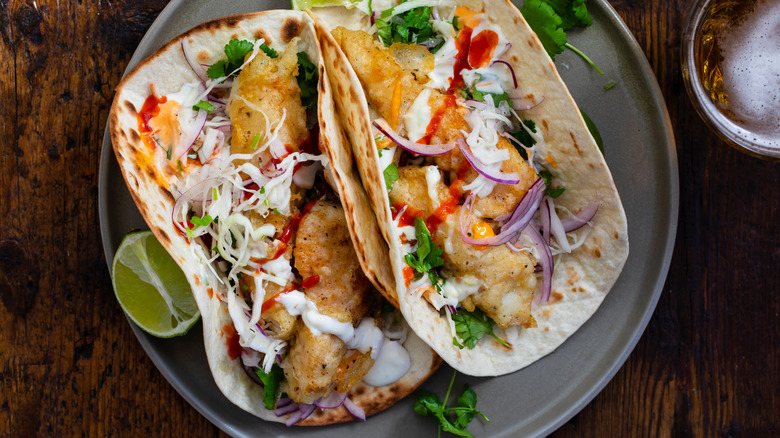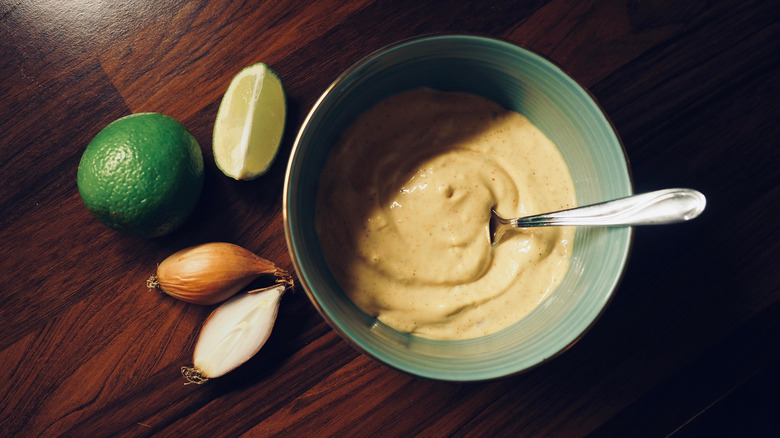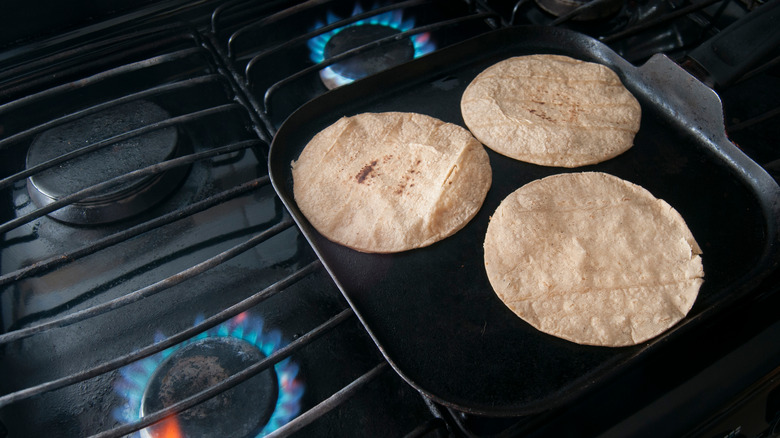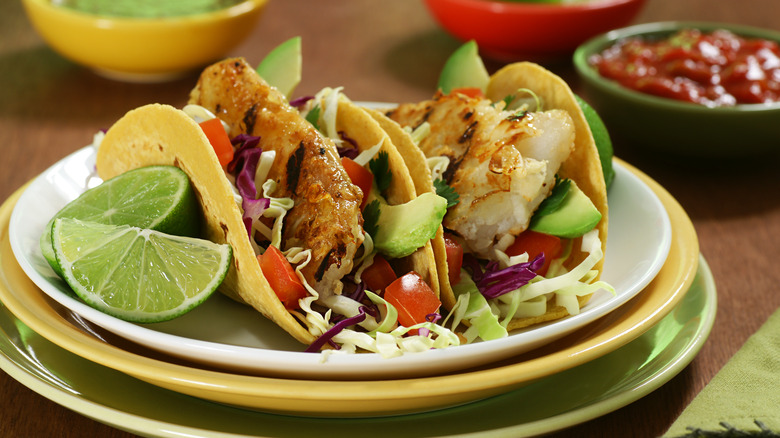10 Chef-Approved Ways To Upgrade Your Fish Taco Game
There's a great story about a group of surfers who headed to Mexico to catch some waves during a bleak American winter in the late 1970s. They were charmed by the clear, warm water of the Baja Peninsula. After catching perfect waves in the sun, they'd sit on the sand, devour beer-battered fish in warm tortillas from a local beach shack, and wash them down with cold beers. They couldn't get enough of this novel and delicious snack. This is the late Ralph Rubio's story, the man behind Rubio's Coastal Grill, who brought fish tacos to America and became the much-loved "Fish Taco King" of San Diego.
But the origins of the fish taco are not an American surfer's story to tell. It's rooted in Mexican heritage and the fishing culture along Mexico's 5,800-mile coastline. The fish taco is thought to have its roots in Baja where Asian traders first introduced the practice of deep-frying to the tortilla-loving nation. The fish taco quickly became a staple in local cuisine. Now, millions of people around the world have the pleasure of enjoying this culinary gem. For the most part, it hasn't been corrupted along the way. A fish taco is a fish taco. However, I have called on the knowledge of eight experts from Mexican chefs, dieticians, and food writers to ensure you have the best tips and tricks to make the finest fish taco at home.
1. Use soft tortillas instead of taco shells
Soft tortillas are used in authentic Mexican fish tacos. The hard taco shells are an American creation, used more in Tex-Mex cuisine. And they fall apart as soon as you bite into them. "I always choose a soft shell taco over a hard shell taco, no matter what the filling," explains Amy Hand, chef and food writer at The Skillful Cook who gleefully worked the line in a popular Mexican restaurant. "This is the traditional Mexican way to eat a taco and it pairs so well with delicately cooked fish." But corn or flour tortilla you may ask.
I spoke to registered dietician Emily Van Eck, and, nutritionally speaking, she says there is a small difference between corn and flour tortillas. "Fresh corn tortillas are made from whole grains, so are likely to be higher in fiber. Whole wheat flour tortillas can be found in some stores, which also contain more vitamins, minerals, and fiber." Corn tortillas are smaller than flour tortillas. Mexican chef Iliana de la Vega, who won the 2022 James Beard Best Chefs Texas Award, says that, although corn tortillas are traditional, it's not criminal to use a flour tortilla (though we doubt she would) because some people find flour tortillas hold up better with the fillings. "If you prefer flour tortillas, select a good-quality tortilla that's about 6 inches in diameter and not too thick." She recommends keeping the tortillas warm and ready to serve.
2. White fish trumps salmon or tuna
According to Jessie-Sierra Ross from Straight To The Hips, Baby, opting for a mild-tasting white fish is a foolproof choice." When it comes to fish tacos, Chef Iliana of El Naranjo suggests mahi mahi, cod, or halibut, and recommends cutting the fish into pieces measuring about 1 by 2-3 inches. Meanwhile, at District Taco, the team favors wild-caught Alaskan Pollock for its texture and mild taste, considering it an ideal foundation for a taco creation.
Ross also recommends cod, tilapia, and snapper as other favorites due to their structural integrity. Our experts recommend that you don't use fatty or oily fish like salmon or mackerel as they tend to have a strong flavor, which can overwhelm the balance of a fish taco. And avoid delicate fish, like sole, which are best served on the bone. And when you can, always choose sustainably. "Choosing more sustainable fish supports the long-term health of overfished species," explains ButcherBox chef-in-residence, Ashley Lonsdale. "Look for MSC or RFM certifications to identify responsibly sourced fish. For an even easier option, you can look to brands like ButcherBox that vet the practices of fisheries."
3. Crumb, flour or batter your fish
Fish is the hero ingredient in a fish taco. Mess that up and your dish is definitely subpar. The same can be said for not pan-charring your tortillas, but I'll get to that. Traditionally, fish tacos have been beer-battered and deep-fried. But it doesn't have to be that way. You could dust the fish in flour and pan-fry it instead. "I love a great piece of lightly beer-battered "Baja-Style" fish for my fish tacos," cooking blogger Jessie-Sierra Ross tells us. She explains that frying the fillets lets the fish cook quickly at high heat, and because it's battered, it keeps all of the tenderness without drying it out while cooking.
She also recommends a larger variety of coating like unseasoned Japanese Panko breadcrumbs, which pack a big crunch. If you want to keep it simple, Amy Hand recommends tossing the fish in curry powder first "for an added burst of flavor." Suppose you're looking for a gluten-free alternative. In that case, Chef Iliana recommends seasoning your fish by creating an adobado "marinade" and then pan-searing it instead of deep-frying. Adobado is a term commonly used in Spanish and Latin American cuisine to describe a style of seasoning meats. It typically consists of a mixture of chili peppers, vinegar, garlic, herbs, and spices.
4. Deep fry or pan fry is your choice
Leah Delyte Di Bernardo, chef, owner, and founder of two restaurants in Southern California, explains there's no "best" way to cook fish for tacos — each method offers its benefits and deliciousness. "It really depends on the flavor profile you're aiming for, and quite possibly what you're drinking," she says.
"Pan-frying: Great for a quick sear, creating a nice crust on the fish. Perfect for busy weeknights. Baking: Ideal for a more hands-off approach and a consistently cooked fish. Grilling: My favorite for summer! High heat seals in the juices and creates a delicious char. Deep-frying: The ultimate indulgence! Deep frying creates a light and airy batter crust that's incredibly satisfying. It takes a bit more attention than other methods but the payoff is a restaurant-worthy fish taco," she explained.
If you're battering the fish, here's how Iliana de la Vega would do it: The beer batter should be well-seasoned with black pepper, salt, and oregano to infuse flavor into the fish. Dredge the fish in flour, shake off any excess, then dip it into the beer batter. Fry the battered fish in vegetable oil heated to 350 F until it's lightly golden. Remove with a slotted spoon or tongs, quickly drain, and serve immediately. If you're pan-frying, remember to coat your fish in seasoned flour or curry powder beforehand, or try the adobo marinade. Use a non-stick pan, add oil, bring to medium heat, and in it goes.
5. Keep it simple
In the 1970s, when Ralph Rubio and his mates were surfing in Mexico, they ate the holy grail of fish tacos with beer-battered fish, diced cabbage, Mexican crema, salsa, and lime, wrapped in a warm tortilla. Simple, creamy, crunchy and tangy. There's no need to stray far away from the fish taco's humble origin. Less is more. "I think fish tacos are best served with a few select ingredients to let the fish sing," Amy Hand shares. Her favorite toppings for fish tacos are fresh avocado, dill, salsa, spicy aioli, and a fresh squeeze of lime.
It's the beauty of simplicity, says Chef Leah Di Bernardo. "Sometimes, letting the fresh flavors of the fish and a well-crafted marinade take center stage is pure magic. A squeeze of lime, a sprinkle of cilantro, and some creamy avocado — that's all you need to allow those delicious components to shine through... It's easier to add than subtract. You don't want a flavor mosh pit in your mouth." The team at District Taco agrees: "If you have good fish... the flavor will shine on its own. Add freshly prepared toppings, a warm, soft tortilla, and the sauce of your choice and you'll be happy!"
6. Include these 3 must-have elements
Let's face it, fish tacos are a gastronomical delight, but what truly elevates them to culinary perfection? According to renowned chefs and food experts, three key elements are non-negotiable: freshness, creaminess, and crunch. Achieving a harmonious balance with fish taco toppings is paramount. Jessica Randhawa, chef and recipe developer behind theforkedspoon.com, advises aiming for a trifecta of freshness, creaminess, and crunch, ensuring a symphony of flavors with each bite. Professional chef, former restaurant owner, and caterer Sylvia Fountaine insists on incorporating crunchy fresh slaw alongside creamy elements like avocado or chipotle mayo, creating a delightful contrast in every mouthful. (If you're vegan, Chef Leah Delyte Di Bernardo recommends making a cashew cream for richness.)
Chef Iliana recommends finely shredded cabbage for crunch, lightly seasoned with olive oil, lime juice, and salt. She advises keeping the cabbage crisp by only adding the seasoning when ready to serve. If you're unsure which cabbage to go for, Chef Leah Delyte Di Bernardo recommends red cabbage as it packs more iron and vitamin A. Complementing this freshness are two essential components: chipotle mayonnaise and salsa Mexicana, adding creamy richness and zesty vibrancy to the ensemble. Salsa Mexicana (also known as pico de gallo), is made with tomatoes, white onion, chile serrano, and cilantro, all seasoned with salt and lime juice. In essence, a truly exceptional fish taco is about balance, where freshness, creaminess, and crunch intertwine and dance on the palate.
7. Settle on the right sauce
A fish taco needs sauce to keep it moist and marry all the flavors together. Chef Iliana recommends pico de gallo and chipotle mayonnaise, and the team from District Taco agrees: "If you aren't sure where to start, we suggest our traditional mix of pico de gallo, flavorful cabbage, and chipotle mayo. You can't go wrong with classic flavors."
Both sauces can be made at home. Chipotle mayonnaise is a popular condiment made by mixing mayonnaise with chipotle peppers or chipotle powder. Chipotle peppers are smoked, dried jalapeño peppers, which impart a smoky and spicy flavor to the mayonnaise. To make chipotle mayonnaise, you typically start with a base of mayonnaise and then add finely chopped chipotle peppers or chipotle powder. Some recipes may also include additional ingredients like garlic, lime juice, cilantro, or spices to enhance the flavor further. Pico de gallo is generally made with tomatoes, white onion, chile serrano, and cilantro, all seasoned with salt and lime juice.
8. Heat your tortillas in a pan
Ever made the mistake of preparing a taco or wrap at home and neglecting to heat your tortilla properly? Perhaps you opted for the microwave, or no heat at all. That's when your fish taco goes from hero to zero. Remember to allocate those extra few minutes to warm up your tortilla before assembling your meal. "Heating tortillas directly over an open flame or in a dry skillet until they are just slightly crispy can significantly improve their taste and texture," advises Jessica Randhawa. If you don't have a skillet, a non-stick pan will do.
Even better, make your own. Check out this classic Mexican corn tortilla recipe and make the tortillas for your fish taco from scratch! There's also the option of placing your tortillas over a grill. "Quickly grilling soft tortillas adds a smoky touch that complements fish tacos... adding a hint of char – yum," shares Chef Leah Delyte Di Bernardo.
9. Presentation is priceless
We can no longer sloppily plate a dish when making fish tacos at home. Instagram and the advent of celebrity chefs and cooking competitions have taught us to take pride in presentation. If you're using corn tortillas, which are smaller than flour tortillas, serve them flat on the plate and carefully layer all the elements on top. "The beauty of layering," says Jessie Sierra Ross, "is that you can keep the crispy fish away from the saucy toppings so the delicious first bite has crunch." And remember not to go too tall when layering all the components because the taco needs to be picked up, folded, and enjoyed without all the toppings falling out. When using a flour tortilla (which is larger) layer the ingredients down the center, fold up the bottom quarter, and then fold in the sides, creating a neat package akin to folding a diaper.
Suppose you're hosting a special event or gathering. In that case, Sylvia Fountaine recommends creating a spread of various toppings for guests to choose from, to turn the meal into a fun experience. "Guests truly enjoy getting creative with making their tacos and trying different things. Having a selection of other proteins, slaws, salsas, pickled items, creamy sauces, and hot sauces allows guests to experiment and enjoy different flavor combinations and stay within any dietary constraints they have," she says.
10. Include seasonal ingredients where you can
Using seasonal ingredients when making fish tacos has its advantages. Firstly, seasonal produce tends to be fresher, tastier, and more nutritious because it's harvested at its peak ripeness. This freshness enhances the overall flavor profile of your fish tacos, making them more vibrant and delicious! "Strolling your local farmers market is the best way to find out what's in season," says Ashley Lonsdale. "An easy way to incorporate seasonal vegetables is by making a slaw. This can be done with any hearty vegetable. I shred or cut one or two vegetables into matchsticks and toss them with lime juice, salt, and pepper. I like to use cabbage, carrots, radishes, onions, leafy greens, celeriac; the list goes on!" she says.
For Jessie-Sierra Ross, each season offers a bounty of options to enhance your fish taco game: "Summer is amazing for ripe tomatoes, spicy chilis, and cilantro for salsa fresca. Or, dish up a sweet and tangy peach salsa during the late summer into the fall. Citrus fruits like oranges, limes, and even pineapple, can perk up winter fish taco recipes too," she says.
Choosing seasonal ingredients is an environmentally conscious way to cook. By using ingredients that are naturally abundant at a given time of year, you reduce the environmental impact associated with food production — it's a win-win for both your taste buds and the environment.
